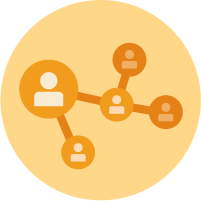Over the years, our team has been asked the question, “what’s the difference between word-of-mouth marketing models?” more times than we can count. We know the intricacies of word-of-mouth marketing can be confusing, but we’re the right people to come to when it comes to navigating which channels are right for your brand.
Why?
Because we’ve relentlessly helped brands leverage the power of word-of-mouth through referral marketing, partner programs, affiliate marketing, and influencer campaigns.
Yes, word-of-mouth comes in different flavors, but the mechanics are virtually the same. The reward processes of all these types of programs are very similar. And, with the right platform, these variants of word-of-mouth can be easily managed and measured in one, seamless experience. Done right, this leads to the same result: Increased brand awareness and revenue growth.
The Difference Between Word-of-Mouth Marketing Models
With all of that said, each word-of-mouth marketing variation does have unique characteristics and they do need to be approached in slightly different ways. So, to clear up some of the confusion, here’s a high-level breakdown of the most common forms of modern word-of-mouth:
 Referral Marketing
Referral Marketing
What is it? Exactly what it sounds like — a strategy for encouraging passionate customers and advocates to directly refer their network to your business.
What makes it unique? Studies show that customers not only seek referrals, they act on them. Referral marketing takes the inherent organic and altruistic nature of referrals and gives brands the tools to incentivize and manage them at scale.
How is it typically managed? We’ve seen some companies build a referral program in-house and others try to manage it manually through email and other basic systems. But the most successful companies automate the process by using one system to enroll, track, manage, and reward its ambassadors.
 Affiliate Marketing
Affiliate Marketing
What is it? A transaction between a company and an entity where the business receives customers (or leads) in exchange for a financial incentive.
What makes it unique? It’s highly efficient because brands specify the cost for a specific action being driven. Examples of effective affiliate incentives include $X per lead (or app download) or Y% of a purchase. Both Netflix and Amazon leverage this strategy well.
How is it typically managed? The challenge with affiliate marketing is that brand recognition has a big impact on success. Attracting “affiliates” is an arduous process and you often have to compete for “space” on a blog. This can sometimes lead to a bidding war, which lowers your margins.
 Influencer Marketing
Influencer Marketing
What is it? In many ways influencer marketing is a modern take on traditional affiliate marketing. Instead of a network of smaller affiliates driving traffic, however, influencer marketing targets specific people who have large, captive followings.
What makes it unique? Today, someone with a million Instagram followers wields an incredible amount of power to drive interest in a product, and many brands are seeing big results by incentivizing those influencers to talk about their products or services.
How is it typically managed? In most cases, marketers manage influencer marketing manually — handpicking target influencers, reaching out to them individually, and tracking the program through spreadsheets and email. There are some software programs designed to manage this process, but they aren’t usually flexible to handle anything other than influencers.
 Partner Marketing
Partner Marketing
What is it? Very simply, partner marketing is a strategy that aims to connect two brands to share one or both brands with the other’s networks. Primarily used in B2B marketing plans, this strategy strives to raise and improve brand awareness amongst similar audiences.
What makes it unique? Engaging and building positive brand relationships with prospects via channel partners, value-added resellers, and agencies produces immediate results similar to customer referrals.
How is it typically managed? More often than not, it’s loosely managed using numerous systems that aren’t exactly designed exclusively for partner marketing (Google Docs, Excel, email, etc.).
What’s the best way to manage these different word-of-mouth marketing models?
Now, let’s revisit the bigger question: Are each of these variations unique enough to require individual technologies? As you might have guessed, I don’t think they do.
Here’s why: At their core, all of these referral sources and lead acquisition channels can be tracked, monitored, and managed in practically the same way. Sure, affiliates certainly require different treatment than customers, and the incentives that resonate with each will vary. Similarly, influencers will obviously be evaluated against different metrics than advocates, and they’ll cost a lot more to engage.
Still, the ways in which all of those different parties are tracked and managed are congruent.
This is precisely why we’re so convinced that the future of our space is a single, flexible platform that delivers all the tools companies need to manage and optimize a variety of campaigns. This approach simplifies the entire process for marketers and, maybe most important, creates a much cleaner experience for customers, affiliates, partners, and influencers.
 5 Reasons To Leverage Word of Mouth Channels In Your Marketing Strategy
5 Reasons To Leverage Word of Mouth Channels In Your Marketing Strategy
Word-of-mouth marketing continues to scale and more and more companies, investors, analysts, and executives are noticing the benefits of utilizing customers, fans, followers, and networks to increase brand awareness and drive revenue.
The shocking part is, word-of-mouth marketing isn’t a modern strategy, or a new-fangled approach to customer engagement and acquisition. In fact, word-of-mouth’s roots can be traced as far back as the Paleolithic Age, when the most influential cavemen leveraged word-of-mouth to share new ideas and lead their communities to the best hunting grounds.
As we’ve evolved over the years, so has the use of word-of-mouth marketing. Today, it remains one of the most trusted and effective strategies for repeatably driving product adoption (just ask brands like PayPal, Dropbox, Spotify, and many others). And, annually, it accounts for billions of dollars in new revenue.
No matter which word-of-mouth marketing model(s) your brand chooses to deploy, here are five reasons word-of-mouth marketing needs to be an integral part of your overall customer acquisition strategy.
#1: The Value of Word-of-Mouth is Skyrocketing
Sure, as word-of-mouth marketers, we’re pretty bias when it comes to leveraging strategies, like referral marketing. But the data also backs us up; referrals are more influential than we think.
In fact, 82% of Americans seek recommendations from friends and family when considering a purchase. More so, 67% say they are more likely to purchase a product after a friend or family share it via social media or email.
What does this mean in practice?
Well, it’s not exactly controversial to suggest that word-of-mouth influences customer buying decisions. There’s a significant correlation between purchasing behavior and word-of-mouth marketing efforts.
Most of us have sought input from our own networks when making a big purchase, or we’ve taken a chance on a new company after hearing a friend or family member rave about its products and services. This is exactly how many of us discovered brands like Airbnb and Uber (two hallmark referral program examples) and it makes sense why we value this form of “marketing” so much. Recommendations from trusted sources tend to come from a very genuine, authentic place.
And these referrals don’t just help us make decisions. Often times, they’re the primary driver of them. The same isn’t usually true of display ads or branded content.
#2: Word-of-Mouth Marketing is a Better Bet than Display Advertising
As of late, one of the most popular avenues for word-of-mouth has become influencer marketing. This strategy positions people to be strong ambassadors of a brand while targeting their engaged following. This is the digitized future of word-of-mouth marketing – and it’s significantly changing the marketing & advertising landscape. While display ads still resonate in some markets, like live sports television, influencer marketing is chewing up display advertising by driving more value and a higher ROI.
The modern consumer also has tools available, like ad blocking technology, to remove unwanted ads from their social streams. This is literally the exact opposite of how consumers treat people they are influenced by. They are choosing to opt-into their opinions, streams, videos and thoughts — they aren’t going to block these people, ever.
It’s actually pretty ironic: 41% of ad blocker users found out about ad blockers via word-of-mouth!
#3: Word-of-Mouth isn’t Limited to Specific Industries
Contrary to popular belief, referrals and influencers are not just for eCommerce brands. In fact, a deeper look into our data revealed that referral marketing is actually industry agnostic.
Word-of-mouth marketing is a natural fit for any vertical where your biggest fans, customers, partners, and influencers are already talking about your brand (or your competitors). No matter the industry, there is one major takeaway: Successful word-of-mouth marketing strategies generate a natural network effect.
As you acquire more referred customers, an abnormally high proportion of them will convert into new brand ambassadors. Those brand ambassadors will then draw in new customers, and the cycle will start all over again.
#4: Incentive Structure Plays a Big Role in Increasing and Scaling Word-of-Mouth Activity
Companies that leverage word-of-mouth marketing are investing in an opportunity to benefit from an active, engaged, and valuably rewarded audience of advocates. Whether it’s a refer-a-friend campaign or an affiliate strategy or influencer marketing, the best program incentives are reflective of the hard work that your members put in as they share good news about your product or service.
There’s no one-size-fits-all approach to developing an incentive structure. In fact, many of our clients have found success with dual incentive structures because both parties feel like they’re being rewarded and valued. Instead of looking for a textbook answer to your incentive structure questions, build a program that suits your company and what you want to reward.
#5: Embed Word-of-Mouth Into Every Aspect of the User Experience
For word-of-mouth marketing programs to consistently deliver truly exceptional results, you must take all marketing channels into consideration.
Basically, your program should be woven into who you are and how you operate. Without structure and commitment, you’re largely hoping that good things happen and that customers inherently know to share your business with their friends, family, and colleagues.
With more marketers headed towards creating personalized experiences for their customer base and prospects, the future for word-of-mouth marketing is bright. It is all about creating experiences worth talking about.
Time and time again, word-of-mouth has been identified as one of the most valuable forms of marketing – the one that customers trust above all others and is most likely to drive sales for your company.
